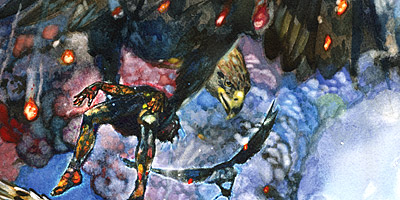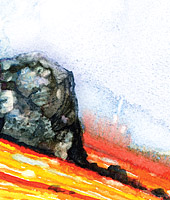The Eagles Are Coming!
How fairy
tales affirm
our hope
 Just as Frodo Baggins loses hope, the eagles rescue him and Samwise from the volcano in J.R.R. Tolkien's The Return of the King. Just as Frodo Baggins loses hope, the eagles rescue him and Samwise from the volcano in J.R.R. Tolkien's The Return of the King.
By Jeffrey Overstreet [jeffreyo@spu.edu]]
Illustrations by Bryan Pollard
On a rocky promontory, two young hobbits cling to life, caught in the fiery cataclysm of an erupting volcano. In the smoke and the blaze, Frodo begins to despair. But his faithful companion, Samwise, looks up to behold the unexpected — rescue, arriving on the wings of eagles.
I read the climactic scene in J.R.R. Tokien’s The Lord of the Rings when I was only 8 years old, and it remains as vivid in my memory as anything in my childhood experience. In my childhood, the world was a scary, even volcanic, place. But in this fairy tale, hope took on a shape so powerful that it enhanced my understanding of the gospel.

|
It happened again in Madeleine L’Engle’s A Wrinkle in Time. Young Charles Wallace fell under the influence of a malevolent villain, a bodiless brain called “IT,” and was imprisoned by pure reason ... quite literally. But his sister Meg came to his rescue with a love so irrational and selfless that it confounded the enemy and broke IT’s power.
So I was excited to join a crowd of aspiring writers at Seattle Pacific University’s 1991 Christian Writers’ Conference, where L’Engle talked about her life and imagination. Delighted to be in Seattle, she said, “This is such a wonderful place to be. You all get to look out at a flying mountain!”
On a hazy day, we can see what she means. Mount Rainier seems suspended over the horizon. A child might be convinced that it defies gravity.
In the tradition of great Christian imaginations such as
Tolkien, C.S. Lewis, and George MacDonald, L’Engle knew the power of asking, “What if?” Through eyes of childlike faith, mountains moved. It was thrill to meet her. L’Engle, who died in September 2007 at the age of 88, wrote several more volumes that I cherished as a teen.
Her stories, along with The Lord of the Rings and Lewis’ The Chronicles of Narnia, remain strangely reassuring. While they take place in imaginary worlds, and illustrate impossible events, fairy tales have given me more real hope than any other form of art. They have, as Tolkien’s benevolent wizard, Gandalf, would say, the “ring of truth.”
Growing up, I watched my peers “put away childish things,” so I became reluctant to admit my continuing love for fairy tales. I was even more embarrassed to reveal that I spent my evenings designing my own mythology. Was I sinking into useless escapism? Elves, wizards, dragons — they’re for kids, right?
In high school, I found encouragement in L’Engle’s memoir, Walking on Water: Reflections on Faith and Art. She explained that she did not perceive age as an isolated chronological statistic, saying, “I am also four, and twelve, and fifteen … and forty-five, and ….” And she believed fairy tales could capture complex ideas in ways other genres couldn’t. “If the book will be too difficult for grown-ups,” she said, “then you write it for children.”
Similarly, C.S. Lewis insisted that fairy tales were not merely stories to be “outgrown.” “When I became a man,” he said, “I put away childish things, including the fear of childishness and the desire to be very grown up.”
For Tolkien, fantasy’s “escape” was to a place where he could see more clearly what was true, false, good, and evil. When hobbits made him famous, he wrote, “It remains an unfailing delight to me to find my own belief justified: that the ‘fairy-story’ is really an adult genre, and one for which a starving audience exists.”
L’Engle, Tolkien, and Lewis — and their inspiration, George MacDonald, 19th-century author of The Princess and the Goblin — understood that the world of make-believe lets us give shapes to our worst fears and deepest longings. The creative inventions of fairy tales allow us to experience the fulfillment of things that have yet to be fulfilled — even the redemption of the world from the consequences of sin.
From Rumpelstiltskin to Where the Wild Things Are, from How the Grinch Stole Christmas to Harry Potter and the Deathly Hallows, fairy tales train us to perceive the sacred in the common, the extraordinary in the ordinary. A common servant girl might be a princess. A shiny apple might contain a poisonous influence. A beast might be saved from beastliness. It’s not hard to find echoes of Scripture’s own stories here. We are all heirs to a great kingdom, children who seized forbidden fruit and fell under a curse, prisoners in need of salvation from beyond.
Further, fantasy draws us back into intimate relationship with the natural world, which speaks so eloquently of the holy. Fire, water, mountains, river, forests, and creatures of all varieties — these things “declare the glory of God” and “pour forth speech” (Psalm 19). In fairy tales, we’re likely to encounter wise trees who teach us about time (Tolkien’s Ents) and lions who wield kingly power (Lewis’ Aslan). Designers for Peter Jackson’s Lord of the Rings films won Oscars, but I suspect New Zealand’s wild grandeur had something to do with the series’ success.
Author Thomas Howard observes that the people of “the Dark Ages” interpreted the natural world as if it was meaningful. Later, preoccupied with scientific discovery, we decided that meaning was dependent only on what we could prove. While Howard champions scientific endeavor, he regrets that our “enlightenment” has “flattened out” the world and disregarded incarnation. Lions are now the subjects of National Geographic specials — specimens to be analyzed — no longer viewed as “the King of Beasts.” Perhaps that’s what C.S. Lewis was getting at when, in The Voyage of the Dawn Treader, Eustace says, “In our world, a star is a huge ball of flaming gas,” and a “retired” star named Ramandu replies, “Even in our world, my son, that is not what a star is, but only what it is made of.”
It can be discomforting to find glimmers of hope in the world outside of the church. After writing about the themes of J.K. Rowling’s Harry Potter stories, I received a letter from a woman who condemned fairy tales, calling them invitations into witchcraft and occultism: “If you think anything meaningful can be conveyed by pagan mythology, you’ve just opened Pandora’s Box!” What could I say? She had just found a “pagan myth” useful in conveying her ideas to me. Potter-protesters were probably surprised when Rowling told MTV.com that her stories were a way of wrestling doubt, and that Scripture verses were woven into the narrative, reflecting her own Christian faith.
Even fairy tales dreamt by storytellers who reject Christianity — Philip Pullman’s atheistic epic The Golden Compass, or Guillermo Del Toro’s Pan’s Labyrinth — sometimes sing with rumors of glory. Audiences cheer when a child of great faith, who knows there are higher powers at work, puts her life on the line for her friends.
Christian hope is not wishful thinking. It is eternity written in our hearts, the God-given expectation of divine grace. And grace does not follow the rules of reason. We can laugh even when things are at their worst, because we know mercy will break through and upset everything our rational minds accept. A prince’s kiss will awaken his sleeping bride. The Word made flesh will lift a terrible curse.
That’s why visions of “happily ever after” thrill us. Tolkien said that fairy tales give us “a piercing glimpse of joy, and heart’s desire, that for a moment passes outside the frame, rends indeed the very web of story, and lets a gleam come through.” It was Tolkien’s view of Christ as the “true myth” at the heart of human history that precipitated the conversion of his atheist friend C.S. Lewis.
When I consider my own failures, I remember Frodo despairing on Mount Doom at the conclusion to The Lord of the Rings. He said to Samwise, “We are lost in ruin and downfall, and there is no escape.” But then I also remember the hope of the gospel, the fairy tale that merged with human history. And with Samwise, I lift my gaze and watch the clouds in anticipation of rescue. The eagles are coming!
The Colors of Auralia
Learn about Overstreet’s first fantasy novel.
Return to top
Back to Features Home
|